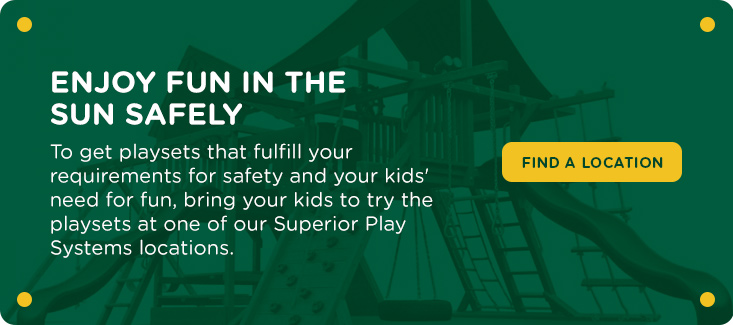How To Protect Your Kids From the Sun on the Playground
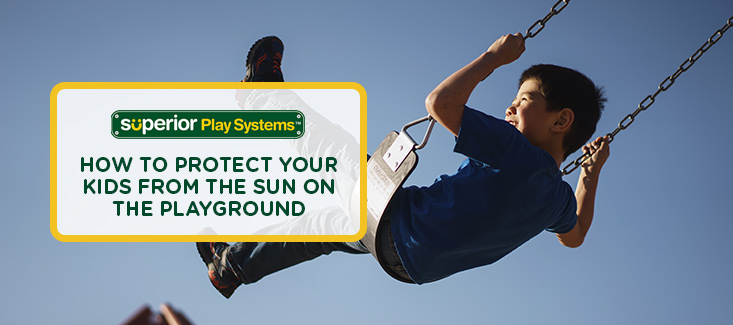
- Why Is Playground Sun Safety Important for Kids?
- Harmful Effects of Too Much Sun
- Sun Safety Tips on the Playground
- Sun Safety for Kids on the School Playground
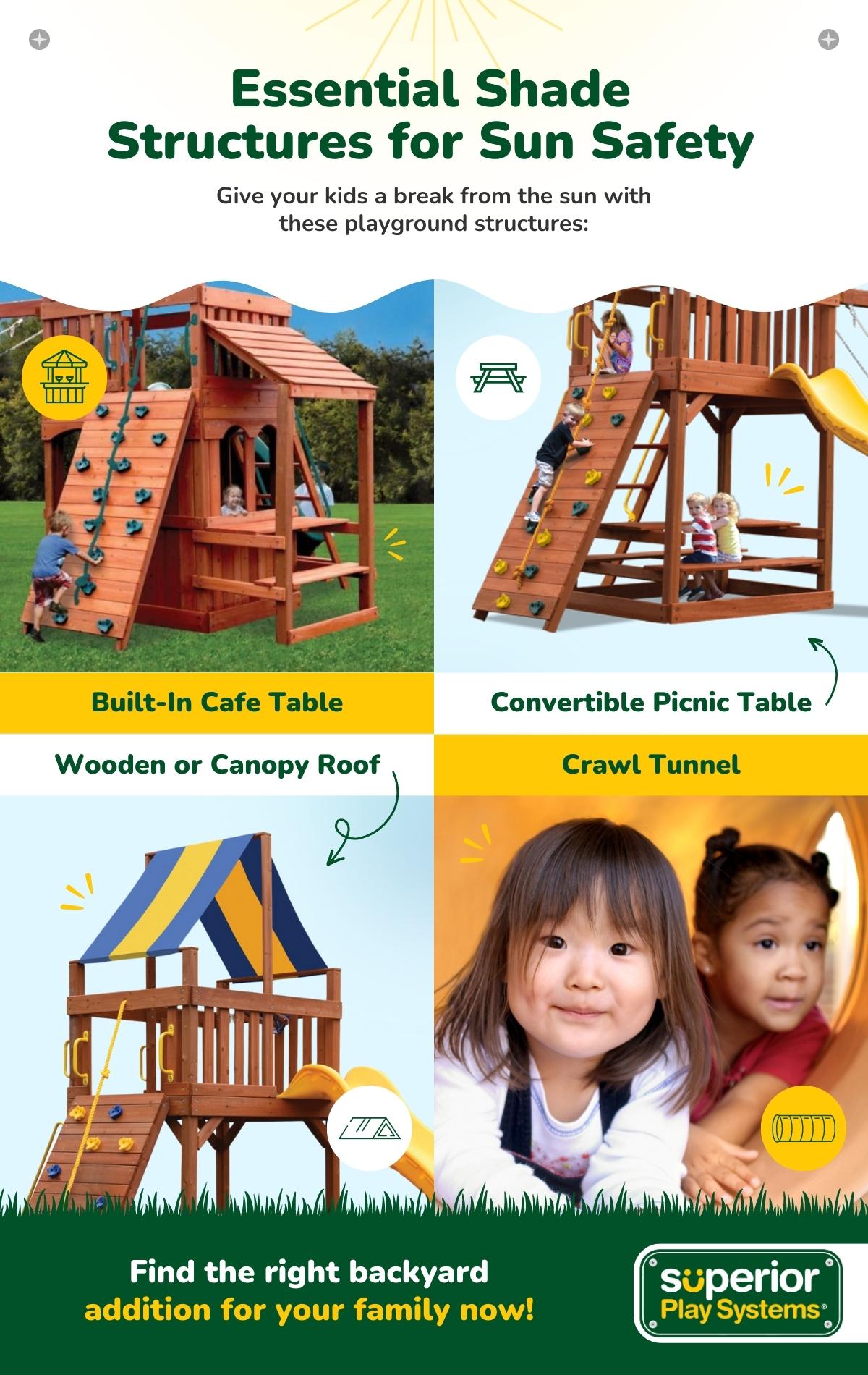
Why Is Playground Sun Safety Important for Kids?
Sun safety on the playground includes not only protecting your kids from sunburns but also keeping them safe from hot surfaces. You cannot trust the play area to have shade to reduce your kids’ sun exposure. The National Program for Playground Safety found only three percent of playgrounds across the country had full shade during the hours of strongest sunlight, between 10 a.m. and 2 p.m. Only 30% had partially shaded areas, but the remaining lacked any source of shade in the play areas.Unfortunately, most children will want to be outside during these hours of peak sunlight intensity. Instead of keeping your kids inside until dusk, protect them from the sun when they do play outside. It’s up to you to keep your kids protected from sun damage. Even on cool or cloudy days, your children risk getting sunburned or getting skin damage from the sun. The ultraviolet rays from the sun cause skin damage, and clouds do not filter out these dangerous UV rays — so don’t forget that sun protection.
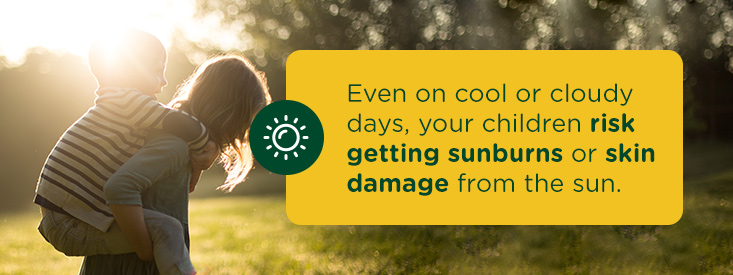 Cooler weather also does not prevent your kids from getting sunburned. Ask anyone who’s gotten a sunburn while skiing. Give your children sun protection all year long, not just during the summer or on hot days. Playgrounds surrounded by concrete, bodies of water, sand or snow can increase children’s sun exposure by reflecting UV rays upward to the children’s skin surfaces.
Cooler weather also does not prevent your kids from getting sunburned. Ask anyone who’s gotten a sunburn while skiing. Give your children sun protection all year long, not just during the summer or on hot days. Playgrounds surrounded by concrete, bodies of water, sand or snow can increase children’s sun exposure by reflecting UV rays upward to the children’s skin surfaces.
When kids have fun on the playground, they may not want to come inside, no matter how hot they feel. As a parent, you also may find it challenging to identify the effects of too much sun exposure, which can happen faster than you think.
For sensitive kids, time in the sun may damage the skin in 11 to 23 minutes. Without protection, all kids can experience sun damage — with their skin turning pink in just 15 minutes. The sunburns won’t appear until 12 hours later. Protection will prevent the pain of sunburns and the potentially life-threatening risk of skin cancer in the future. In fact, using SPF 15 sunscreen daily can cut the chances of developing melanoma nearly in half.
Harmful Effects of Too Much Sun
Too much sun can produce sunburns within a day, but exposure builds up over time to raise the lifetime risk of skin cancer. By the time your children turn 18, they will have experienced 23% of their lifetime sun exposure. Protecting them while young can help lower their cancer risks. Just five sunburns can double the risk of melanoma, but a single blistering sunburn will do the same. Up to 86% of melanomas have their origins in sun exposure. For non-melanoma skin cancers, 90% come from excessive UV rays. While time in the sun causes long-term effects, you and your kids may feel more concern over the short-term results of too much sun. Sunburns can cause pain and blistering the day after being in the sun. Children have thinner skin that is more susceptible to burning from sun exposure. Even if you don’t think you would get burned outside, your kids will. Too much sun turns into a medical emergency for infants under a year old. Go to an emergency clinic or call your doctor immediately if your baby has a sunburn. Your older kids still need medical attention if they have a fever, blistering, severe pain or lethargy after a sunburn.
While time in the sun causes long-term effects, you and your kids may feel more concern over the short-term results of too much sun. Sunburns can cause pain and blistering the day after being in the sun. Children have thinner skin that is more susceptible to burning from sun exposure. Even if you don’t think you would get burned outside, your kids will. Too much sun turns into a medical emergency for infants under a year old. Go to an emergency clinic or call your doctor immediately if your baby has a sunburn. Your older kids still need medical attention if they have a fever, blistering, severe pain or lethargy after a sunburn.
Even if your kids have mild or moderate sunburns, they could still become dehydrated and experience pain. Do not let them back into the sun until the burn has fully healed. Also, focus on replenishing their fluids, especially if they don’t urinate as often as they usually do or have dark-colored urine.
When it comes to UV radiation exposure, you must protect your kids to reduce long-term skin cancer risks and lower short-term sunburn chances.
Sun Safety Tips on the Playground
Protect your kids anytime they go outside. While playing outside will help their bodies to create vitamin D, they don’t need limitless, unprotected exposure. They will get enough vitamin D after only 15 minutes in the sun. Beyond this, you must provide sun protection for children of all ages — especially younger ones, who have delicate skin.1. Sunscreen for All Ages
For younger children, physical barriers in sunscreens protect with less irritation. Look for titanium dioxide or zinc oxide as the main ingredients in the product. Also, look for a broad spectrum sunscreen that protects against the two types of cancer-causing rays — UVA and UVB.The SPF of sunscreen should be at least 30, but your kids won’t get more protection for the pricier 100 SPF products. Anything over SPF 50 will only cost more money without offering additional protection. To get the maximum protection from the sunscreen, generously apply it half an hour before your kids go outside. This early application gives the skin time to absorb the sunblock.
Regardless of the type, always reapply sunscreen every one to two hours, more frequently if children are swimming or sweating. Use at least one ounce, about two tablespoons, per application.
To ensure your kids practice life-long sun protection, get into the habit of applying sunscreen to them daily, even in winter. Regular sun protection can prevent cancer and ensure they have sunscreen on for unexpectedly long periods of sun exposure.
2. Physical Barriers to the Sun
While sunscreen provides some protection, not all children can wear it. Even for those who can, adding layers of physical protection will increase their levels of sun safety.Choose long sleeves and sun hats for your kids. Look for clothing that offers a UPF of 30. Don’t forget the sunglasses to keep your kids’ eyes safe from the sun’s damaging rays.
Infants
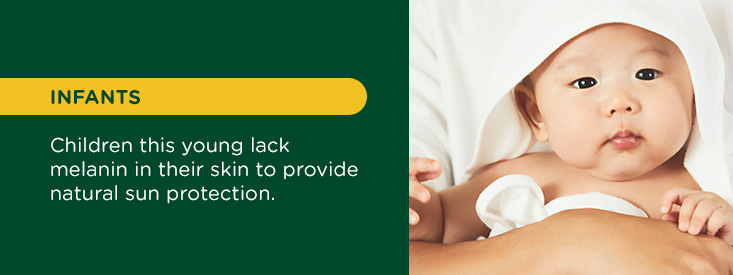 Don’t take infants under six months outside or provide them with heavy sun protection. Children this young lack melanin in their skin to provide natural sun protection. Most sunscreens, unfortunately, can irritate youthful skin. Talk to your pediatrician about specific sunscreens, but few products exist for this young age group.
Don’t take infants under six months outside or provide them with heavy sun protection. Children this young lack melanin in their skin to provide natural sun protection. Most sunscreens, unfortunately, can irritate youthful skin. Talk to your pediatrician about specific sunscreens, but few products exist for this young age group.
If you cannot get your child in the shade, sunscreen may be an option. Test a small amount of sunscreen on your babies to see if it irritates. If not, the American Academy of Pediatrics recommends a small amount of sunscreen only if it will be the only way you can protect your infants from the sun.
If sunscreen irritates your infant, you will need to create physical barriers between your them and the sun. Avoid taking your baby outside during the hours of strongest sunlight around midday. Always bring canopies or umbrellas to keep your youngest children in the shade. Keep clothing loose to protect them from the heat, but ensure their skin has complete coverage from the sun. Also, try to find a sun hat. Your little ones will look cute and avoid sunburns.
Toddlers and Children
Toddlers and young children still have susceptible skin that burns quickly but may have adverse reactions to sunscreen. Test a small amount inside your young kids’ wrists to see whether local irritation develops. If it does, do not use that sunscreen. Instead, talk to your pediatrician for recommendations for sunscreens for highly sensitive skin. In the meantime, keep your child protected with sun protective clothing.For other kids who can use sunscreen without a problem, make it a daily habit. Apply sunscreen before school and encourage them to reapply if they go outside for physical education or recess. Check with the school’s policy first concerning kids and sunscreen.
If you will be outside with your kids, set a timer on your phone to stop play every one to two hours and reapply sunscreen. Doing so will ensure your kids don’t lose protection as they sweat or wipe off the sunscreen you applied before they went outside.
For kids resistant to wearing sunscreen, sunglasses, hats or UPF clothing, make a game of it. Call the hat something that appeals to the kids, such as a ranger hat or zookeeper’s hat. Point out how these professionals wear such gear when they work the next time you visit a park or zoo. The more of a regular habit you make sun protection while your kids are still young, the easier it will become for them to protect themselves from the sun when they grow older.
Teens
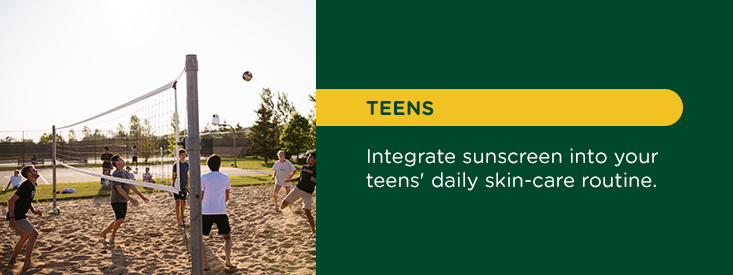 By the time your kids reach their teenage years, they have already established many lifelong habits, such as whether they wear sun protection or not. You can talk to your teens as adults, especially about the risks of skin cancer from not using sun protection. If that does not work, talk about the effects of the sun and premature aging as a means of convincing them to use sunscreen.
By the time your kids reach their teenage years, they have already established many lifelong habits, such as whether they wear sun protection or not. You can talk to your teens as adults, especially about the risks of skin cancer from not using sun protection. If that does not work, talk about the effects of the sun and premature aging as a means of convincing them to use sunscreen.
Too often, kids in their teenage years may want to use tanning beds or tan outside. Both options can lead to skin cancer, and you must have regular talks with your kids about the dangers of using tanning beds. Compared to being outside, tanning beds deliver up to 15 times the amount of UV rays to the skin, further increasing the chances of cancer.
Integrate sunscreen into your teens’ daily skin-care routine. If your kids have a problem with acne, look for sunscreen products that don’t clog pores and cause breakouts. Your teens should not use acne as an excuse to avoid wearing sunscreen. Give them sunscreen to put on during sports activities or gym while at school, and check in regularly to see how well they maintain their sun protection routine. While teens are more independent, they still need you to protect them from the sun.
Sun Safety for Kids on the School Playground
While you cannot go to school with your kids, you can do some things to ensure the school knows how to protect children from the sun. Many schools allow children out on the playgrounds during the hottest, sunniest parts of the day. If you cannot be there to provide sunscreen for your children, see how you can make changes at the schools to improve sun protection for your kids and all others who attend.Look over your kids’ school’s policies regarding sun hats, long sleeves and sunscreen. Some schools treat sunscreen as a medicine that requires the nurse to apply it only with a parent’s note. Talk to the schools’ administrations to see what you can do to have such rules changed if they prevent your kids from wearing sunscreen on the playground. Work with the schools to improve shade around playground areas. Remember that sun safety for kids on the playground also includes having shady areas they can play in. If needed, see if your children’s schools’ have fundraising opportunities to plant trees or purchase sun canopies for the play areas.
Emulate proper sun protection yourself. When you become a role model for your kids, they will want to also practice the same habits when they are away from you. Encourage your children’s teachers to do the same, so your kids will see all the adults in their lives acting to stay healthy in the sun. Give your kids the equipment they need to stay safe outside. Make sure they take a wide-brimmed sun hat, long-sleeved shirt, sunglasses and sunscreen to school. Discuss the importance of sun protection with your kids’ teachers if your children receive notice that they cannot wear their sun protection gear while on the playground.
To keep your kids safe from the sun while at school, you need to become an advocate for their health and safety. Be ready to talk to everyone at your children’s schools about sun safety and why your kids and others need protection from the sun while outside.
Let Your Kids Enjoy Fun in the Sun Safely
By protecting your kids from the sun, you can let them enjoy their time on the playground with less worry. Preventing sunburns ensures more extended play for your kids because they’ll be able to play all summer long without needing to stay inside to heal sunburn.You also want your kids to have fun, safe playground equipment that doesn’t reflect the sun’s rays or become too hot on the surfaces. To get playsets that fulfill your requirements for safety and your kids’ need for fun, bring your kids to try the playsets at one of our Superior Play Systems® locations. If you cannot find a site near your home, shop online or contact us for any questions you have about our showrooms, products or birthday parties.
